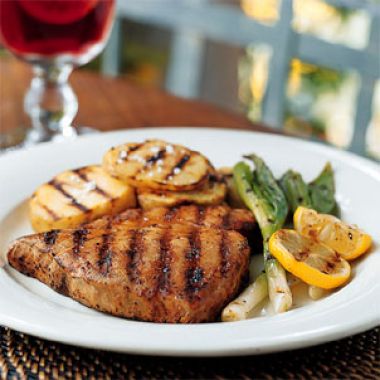
A prized food fish, the tuna comes from a family of large fish with rich, oily, firm flesh. Tuna is the most popular fish for canning and is widely available in cans in several different forms. The albacore, a small tuna (10 to 60 pounds) with the palest flesh of all the tunas, is mild in flavor and almost white in color when cooked. The bluefin is a very large fish—it can grow to more than 1,000 pounds—whose mature flesh is dark red and strongly flavored. Bonitos are small fish (up to 25 pounds) and have the most pronounced flavor among all the tunas. Skipjack tunas are usually quite small (6 to 8 pounds), with meat similar to that of the yellowfin. Yellowfin tuna, which can reach a weight of 300 pounds, is called ahi in Hawaiian. It has slightly more flavor than albacore.
Because its meat is oily and firm, tuna takes well to pan roasting or grilling. It is typically cooked until seared on the outside and rare on the inside. Fresh tuna is also used for Japanese sashimi and sushi. Canned tuna is served as part of an antipasto plate and is used to make salads, sandwiches and casseroles.
Selecting
Fresh albacore is usually available from spring through fall, while yellowfin is available year-round but is most plentiful in summer. The different kinds of fresh tuna are interchangeable for cooked dishes, although yellowfin steaks are often preferred for grilling and pan roasting. For sushi and sashimi, look for the freshest-possible fish, usually labeled "sushi-grade," "sashimi-grade," "tuna loin" or "tuna belly."
When choosing canned tuna, imported Italian tuna packed in olive oil is considered the premium kind for antipasto, salads and sandwiches, although you may prefer a lower-calorie tuna packed in spring water. Domestic tuna is also packed in vegetable oil. Solid albacore tuna is the most expensive domestic canned tuna, followed by chunk light tuna and then flaked light tuna. Solid albacore can be somewhat dry, however, and some cooks prefer chunk light tuna. "Dolphin-safe" or "line-caught" tuna has been caught by methods that do not endanger dolphins.
Storing
Pat fresh tuna dry with paper towels and put it in a heavy-duty zippered plastic bag. Place the bag on top of a bowl of ice cubes or cracked ice and refrigerate. Cook the fish the day you buy it. If you must wait, it should be kept no longer than 24 hours. Freezing degrades the texture and flavor of fish somewhat, but if you must freeze tuna, place it in a freezer-weight plastic bag and freeze for up to 1 month. Defrost in the refrigerator. Unopened canned tuna may be kept indefinitely.
Preparing
Fresh tuna may be grilled, broiled, panfried, pan roasted or poached. Canned tuna is usually drained before it is used in a recipe.
Adapted from Williams-Sonoma Kitchen Companion: The A to Z Guide to Everyday Cooking, Equipment and Ingredients (Time-Life Books, 2000)













